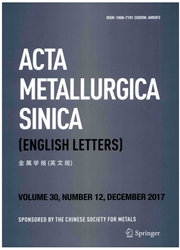

 中文摘要:
中文摘要:
谷物边界工程(GBE ) 是通过增加低巧合地点格子(CSL ) 的比例改进电阻到材料的谷物边界失败的一个惯例在谷物边界特性分发(GBCD ) 的谷物边界(特殊谷物边界) 。在冷卷并且退火的 Fe-18Cr-18Mn-0.63N 高氮的奥氏体的不锈钢的 GBCD 被电子背分析散布衍射(EBSD ) 。结果证明在常规奥氏体的不锈钢的 GBE 的优化过程不能很好被用于这高氮的奥氏体的不锈钢。谷物边界能为稳固的答案从 47.3% 增加的低 CSL 的百分比在卷减小然后为 10 min 在 1423 K 退火的 5% 寒冷以后为标本对待高氮的奥氏体的不锈钢标本到 82.0% 。高比例的这些特殊边界有效地打断常规高角度谷物边界网络的连接并且因此为高氮的奥氏体的不锈钢完成 GBCD 优化。
 英文摘要:
英文摘要:
Grain boundary engineering(GBE) is a practice of improving resistance to grain boundary failure of the material through increasing the proportion of low Σ coincidence site lattice(CSL) grain boundaries(special grain boundaries) in the grain boundary character distribution(GBCD). The GBCD in a cold rolled and annealed Fe-18Cr-18Mn-0.63N high-nitrogen austenitic stainless steel was analyzed by electron back scatter difraction(EBSD). The results show that the optimization process of GBE in the conventional austenitic stainless steel cannot be well applied to this high-nitrogen austenitic stainless steel. The percentage of low ΣCSL grain boundaries could increase from 47.3% for the solid solution treated high-nitrogen austenitic stainless steel specimen to 82.0% for the specimen after 5% cold rolling reduction and then annealing at 1423 K for 10 min.These special boundaries of high proportion efectively interrupt the connectivity of conventional high angle grain boundary network and thus achieve the GBCD optimization for the high-nitrogen austenitic stainless steel.
 同期刊论文项目
同期刊论文项目
 同项目期刊论文
同项目期刊论文
 Optimization of Grain Boundary Character Distribution in Fe-18Cr-18Mn-0.63N High-Nitrogen Austenitic
Optimization of Grain Boundary Character Distribution in Fe-18Cr-18Mn-0.63N High-Nitrogen Austenitic Effects of Coiling Temperature on the Microstructures, Mechanical Propertiesand Textures of 08Al dee
Effects of Coiling Temperature on the Microstructures, Mechanical Propertiesand Textures of 08Al dee Plastic Deformation and Damage Behaviors of Fe-18Cr-18Mn-0.63N High-Nitrogen Austenitic Stainless St
Plastic Deformation and Damage Behaviors of Fe-18Cr-18Mn-0.63N High-Nitrogen Austenitic Stainless St Effects of Cold Deformation and Aging Process on Precipitation Behavior and Mechanical Properties of
Effects of Cold Deformation and Aging Process on Precipitation Behavior and Mechanical Properties of 期刊信息
期刊信息
